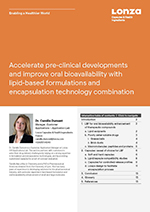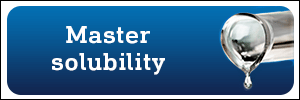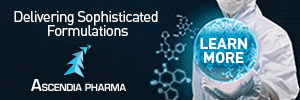Bioavailability & Solubility
SPECIAL FEATURE - Excipients: Advanced Biologics Require Innovative Excipient Science
Contributor Cindy H. Dubin speaks with several leading companies to discuss novel and functional excipients being developed, the role they will play in reformulations and new formulations, and their versatility in drug delivery.
FORMULATION DEVELOPMENT - Solving Tough Solubility Issues With Fewer Compromises & Better Outcomes
Anshul Gupte, PhD, says fortunately, enhanced solubility can be achieved using a variety of approaches. For oral solid dosage forms, well-established approaches include micronization, nanoparticles, amorphous solid dispersions (ASDs), lipid-based formulations, salts, and co-crystals.
DRUG DELIVERY PLATFORM - VitalDose® EVA Implants for Systemic & Local Delivery of Therapeutics
Cyonna Holmes, PhD, Karen Chen, MS, and Brian Duke explain how systemic delivery approaches that leverage continuous dosing can address adherence issues and improve drug effectiveness while minimizing adverse reactions, and how a localized delivery approach can minimize total drug exposure, reduce off-target toxicities, and overcome targeting issues.
WHITEPAPER - Manufacturing of 10-mg Loratadine Self-Emulsifying Drug Delivery System (SEDDS) Tablets by Direct Compression With ABISORB-DC & ABISOL Emulsion Preconcentrate Kit
10-mg loratadine SEDDS were successfully manufactured with ABISORB-DC(TM) and ABISOL(TM) 2 by direct compression on a rotary tablet press, employing standard pharmaceutical manufacturing equipment…..
SPECIAL FEATURE - Improving Bioavailability & Solubility: The Never-Ending Quest
Contributor Cindy H. Dubin speaks with several companies to review their innovative technologies in this annual report on bioavailability and solubility.
FORMULATION FORUM - Nanoparticle Technologies Used in Ocular Drug Delivery
Shaukat Ali, PhD, and Jim Huang, PhD, describe the basic understanding of eye diseases, challenges in ocular drug delivery, and the future trends in development of innovative drugs.
PBPK MODELING - Critical Parameters for Simulating Oral Absorption Using PBPK Models
Deanna Mudie, PhD, says with an increasing number of drugs posing absorption challenges, the ability to predict how a new molecule will behave in vivo is important, and being able to predict and mitigate absorption problems before they arise should help the project progress with fewer delays.
FORMULATION FORUM - Lipid Nanoparticles – Carriers for Nucleic Acids Delivery
Shaukat Ali, PhD, and Jim Huang, PhD, describe the role of individual components in aggregation, packing, stability, efficacy, and potency of nucleic acids, the understanding of which is important to achieve better designed and smarter formulations, and robust scale up and manufacturing of LNPs.
SPECIAL ROUNDTABLE - Leadership Panel: 4 Trends That Will Have the Most Impact on Drug Development in 2024
Contributor Cindy H. Dubin asked some of today’s life science leaders what they expect will have the greatest impact on drug development in 2024 and beyond.
2024 COMPANY PROFILES & CAPABILITIES
For each participating company, this section presents a detailed summary highlighting their core technologies, capabilities, technologies, and services.
EXCLUSIVE ONLINE CONTENT

Novo Holdings to Acquire Catalent
Catalent, Inc., a leader in enabling the development and supply of better treatments for patients worldwide, and Novo Holdings, a holding and investment company that is responsible for managing the assets and wealth of the Novo Nordisk Foundation, recently announced they….

Ensysce Biosciences Announces FDA Breakthrough Therapy Designation Granted for PF614-MPAR
Ensysce Biosciences, Inc. recently announced receipt of notice from the US FDA that it has granted Breakthrough Therapy Designation (BTD) for PF614-MPAR. A next-generation opioid, PF614-MPAR represents a major….

Lexaria Bioscience Improves Delivery, Efficacy of GLP-1 Agonists Through Proprietary Drug Delivery Platform
Lexaria Bioscience Corp. recently announced its placement in an editorial published by NetworkNewsWire (NNW), one of 60+ brands within the….

Conduit Pharmaceuticals Partners With ClinConnect on Cocrystal Development Program
Collaboration underscores Conduit’s mission to advance promising treatments by developing assets that have already completed Phase 1 trials….
New Collaboration With Stevanato Group to Elevate mRNA Production With Nfinity Platform
Quantoom Biosciences recently announced a new collaboration with Stevanato Group, a leading global provider of drug containment and delivery solutions to the pharmaceutical, biotechnology, and life science industries, with the goal of….
MARKET NEWS & TRENDS
WEBINARS

WEBINAR - Nanoparticle Suspensions: History, Applications & CMC Aspects
This webinar describes the history, CMC aspects, and potential applications of nanoparticle suspensions (NSs). This drug delivery technology should be considered for crystalline, sparingly water-soluble APIs. The presentation highlights….

WEBINAR - Beyond the Lab: Unleashing the Potential of In Silico Modeling in Drug Product Formulation
In this webinar you will learn how digital chemistry tools facilitate rapid screening of formulation parameters, aiding in the identification of optimal drug delivery systems, excipient selection, and dosage forms….

Where Do We Stand on Poorly Soluble Drugs and Peptides in Oral Delivery?
The Rule of 5 suggests that, for oral bioavailability, a better chance for oral absorption is obtained when the molecules are within the parameters of the Rule of 5’. However, the pharmaceutical industry is achieving oral efficacy with drugs that exceed….
Quotient Sciences: Upcoming Solubility Enhancement & Pediatric Development Webinars
Access our webinars on solubility strategies & pediatric drug development….
WHITE PAPERS

WHITEPAPER - Manufacturing of 10-mg Loratadine Self-Emulsifying Drug Delivery System (SEDDS) Tablets by Direct Compression With ABISORB-DC & ABISOL Emulsion Preconcentrate Kit
10-mg loratadine SEDDS were successfully manufactured with ABISORB-DC(TM) and ABISOL(TM) 2 by direct compression on a rotary tablet press, employing standard pharmaceutical manufacturing equipment…..

WHITEPAPER - Copolymer Microstructures: Connecting Monomer Sequence Distribution With Biomedical End-Application Performance
To gain insights into advanced copolymer characterization techniques and their impact on drug release in biomedical products, we invite you to explore the latest Corbion white paper…..

WHITEPAPER - Accelerate Preclinical Developments & Improve Oral Bioavailability With Lipid-Based Formulation & Encapsulation Technology Combination
This paper covers the benefits of the LBF and capsules combination in dosage form developments, an efficient technology platform to bring efficient and differentiated products to the market.

WHITEPAPER - Improving API Solubility by Salt & Cocrystal Formation
Ensuring sufficient solubility is critical to the success of small molecule drugs. An active pharmaceutical ingredient (API) must be absorbed by the body and enter the systemic circulation to deliver the desired therapeutic effect. Many APIs,….

WHITEPAPER - Overcoming the Knowledge Gap: Long-Acting Injectables & Implantables
This whitepaper delves into the numerous benefits of long-acting drug delivery systems, including their ability to harness highly potent APIs, streamline development and intellectual property protection, and provide consistent drug release over extended periods.
Bioavailability and Solubility Challenges
Given that a large number of drugs fail to reach the market due to poor solubility and bioavailability, the industry is seeking various methods to mitigate this challenge while many choose to re-formulate existing product candidates. Either way, the demand for novel bioavailability and solubility enhancement methods has grown significantly. To cater to this increasing demand, many contract manufacturers and technology developers have emerged.
What is Solubility?
Solubility is the ability for a drug to be dissolved in an aqueous medium. Drug solubility is defined as the maximum concentration of a substance that can be completely dissolved in a given solvent at a certain temperature and pressure level.
Solubility of drugs is measured by the amount of solvent needed to dissolve one gram of the drug at a specific temperature. For example, a drug that is very soluble needs less than one part solvent to dissolve one gram of the drug. How soluble a drug is varies widely—a drug that is considered soluble needs 10-30 parts, one that is slightly soluble needs 100-1,000 parts and one that is practically insoluble or insoluble needs more than 10,000 parts. How soluble a drug is depends on the solvent, as well as temperature and pressure.
Since 1975, approximately 60 marketed drugs have leveraged solubilization technologies to enhance oral bioavailability. In the preceding 36 years, from the time the FDA required submission of an NDA in 1938, solubilization technology was virtually unused on a regular basis. Apparently, the disease areas focus, drug discovery methodologies, and the lack of mature solubilization platforms restricted the use prior to the 1970s.
In comparison, the past nearly 4 decades have shown robust growth in the reliance on solubilization platforms, accounting on average for around 9% of all NMEs approved from 1975 through 2022, and more than 10% in the past decade. Some years stand out to validate the need and use of solubilization platforms. For example, in 2005, 20% of NMEs approved used technologies including solid dispersion, lipid, and nanocrystal platforms. The data for the most recent 4-year period (2010-2013) seems to represent a slight decline in growth, but it is still early in the decade, and the data set is relatively small. Based on the trends throughout the past 4 decades and the changing chemical space in drug development, we expect the decade will show additional and significant current growth in use of solubilization technologies once we have visibility into the full 10-year period.
Bioavailability & Solubility Impediments
The biggest impediment in addressing bioavailability issues likely lies with a lack of deep familiarity with enabling technologies. Improving drug bioavailability begins with a thorough evaluation of the API’s physical and chemical properties in relation to solubilization in the dose, but more importantly its dissolution in vivo at the site of absorption.
These technologies, such as nanoparticles, cocrystals, computer-aided prodrug design, and electrospinning, represent innovations aimed at enhancing the solubility of a candidate molecule, particularly in the gastrointestinal tract. Technologies such as electrospinning, deep eutectic solvents, and ionic liquids are upcoming formulation approaches to enhance drug solubility, and as the science matures, and the relative strengths and weaknesses are better understood, we expect to see further application of these innovative approaches. They have shown to be successful for some compounds, and have a place alongside other bioavailability enhancement technologies, where each strategy has its benefits and corresponding liabilities. For them to be successful and widely adopted however, they will also have to provide a compelling benefit compared with other well-understood, and commercially precedented technologies, such as amorphous solid dispersions and lipid-based formulations.
Extreme compounds require either significant amounts of stabilizers to maintain the amorphous state or they are not amenable to common manufacturing technologies with reasonable cost of goods due to their low solubility in organic solvents. These include amorphous solid dispersions using polymethacrylate, cellulose, or povidone-based polymeric carriers, she says. In addition, thermostability of new molecular entities becomes an issue as most new molecules have melting points well above 400°F. Alternative production methods for amorphous solid dispersions can address these issues.






